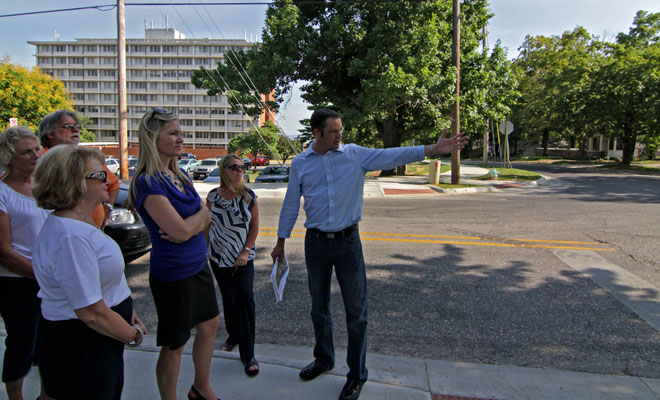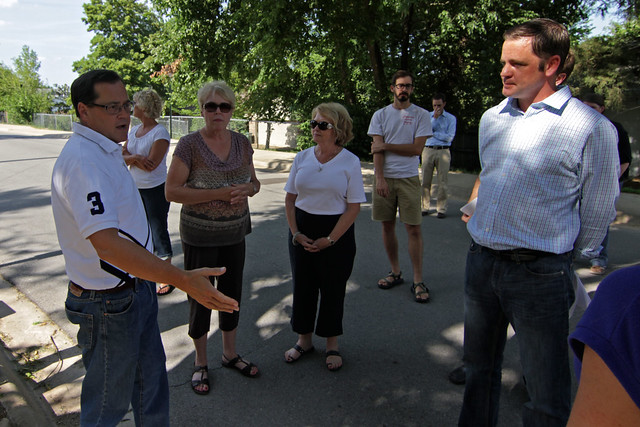
Seth Mims leads members of the Fayetteville City Council and area neighbors on a walking tour of a proposed student apartment complex Thursday across from the University of Arkansas campus near the intersection of Cleveland Street and Razorback Road.
Photo: Todd Gill, Flyer staff
The Fayetteville City Council will hear a second round of arguments both for and against Project Cleveland, a planned student housing project across the street from the University of Arkansas campus.
Seth Mims and Jeremy Hudson with Specialized Real Estate Group, the developers behind Eco Modern Flats and two other planned downtown apartment buildings (Eco Downtown and Sterling Frisco), are proposing a 122-unit complex at West Cleveland Street and North Hall Avenue.
Mims and Hudson are once again working with Portland-based real estate investor Robert Dant and Fayetteville architecture firm Modus Studio.
The 2.71-acre site is currently home to the 60-unit Bayyari Properties-owned Sunshine Place apartment complex across from a five-story university dorm and a Leverett Elementary School parking lot.
Proposal updated

Mayor Lioneld Jordan (right) listens as Seth Mims outlines plans for Project Cleveland while Modus Studio architect Chris Baribeau talks with Ward 4 Alderwoman Sarah Lewis.
Photo: Todd Gill
Before taking public comment during the council’s first official hearing of the project on June 5, city staff outlined several changes that have been made since the proposal was first presented.
Jeremy Pate, the city’s development services director, said the project originally included structures that staff and neighbors believed were too large and that didn’t provide adequate transition from the campus to the neighborhood.
After several meetings with both city planners and area residents, Pate said the developers scaled back their plans in hopes of gaining staff and neighborhood approval.
The five-story complex was lowered to two stories where it meets the neighborhood and although the south end of the building will remain five stories tall, it will be about 15 feet shorter than the UA dormitory across the street due to a difference in land elevation.
“This current proposal, we felt finally provided a transition that was appropriate with the multi-story student housing to the south and the single-family neighborhood to the north,” said Pate.
Mims said those weren’t the only changes made at the request of the neighbors.
“We have taken public comment very seriously and our proposal has changed dramatically,” said Mims who outlined a timeline which ultimately removed 100 units from the original plan. Mims said the 222-unit complex was lowered to 170 units and then again to 122 units after hearing multiple complaints that the development was too large.
Neighbors remain opposed
Some neighbors, however, remain opposed to Project Cleveland for several reasons.
Rebecca Harrison, who walks her dog along Cleveland Street, said the project would be “too much” for the already established neighborhood. “We’ve already had Razorback Road widened and Garland Avenue widened,” she said. “I would be happy if it would just stay the way Mr. Bayyari had it.”
During a City Council tour of the area last week, Mims told council members he would address safety and frontage issues by replacing the deteriorating sidewalk with a new, eight-foot-wide sidewalk and by constructing a new curb and protected “climbing lane” for eastbound bicycle traffic from Sang Avenue to Razorback Road.
Other planned additions and traffic-calming items include raised intersections with embedded LED lighting, consolidation of two existing crossings near Leverett Elementary into newly constructed 10- and 24-foot-wide raised crosswalks, and, if approved by the city, prohibited left turns out of the complex onto Hall Avenue.
Mims said with rising attendance numbers at the university creating more apparent housing issues for those enrolled, student apartment construction is inevitable.
“The best place for that sort of housing is right next to campus,” he said. Being across the street from the university will encourage students to walk to class instead of driving which will create a safer situation for everyone, said Mims. “That is all very much in the spirit of Fayetteville,” he said.
Ken Gardner, who lives on Hall Avenue, questioned the motives of the developers.
“Do we believe the altruistic values of the developer to help the university find housing for their students or do we choose to believe this is driven to develop profits for a company in Oregon that has money behind this?”
Gardner said he’d likely sell his property to the university and move out of the neighborhood if the council approved the complex.
Traffic effects to be addressed
Pate said the most discussed item so far has centered around the effects the project would have on traffic in the area.
“Under no circumstances do we feel like traffic won’t be increased,” said Pate, “but it’s not as much as it would be if it were in another neighborhood.”
Modus Studio architect Chris Baribeau said two recently commissioned studies were provided to the city which projected minimal increases in traffic, mostly due to the site’s close proximity to campus which could reduce the chances of students driving to class.
Baribeau said traffic engineers would be available at this week’s council meeting to explain why they believe the area will see traffic increases of no larger than five percent during peak hours of the day.
Tuesday’s City Council meeting is set for 6 p.m. inside room 219 of Fayetteville City Hall.


